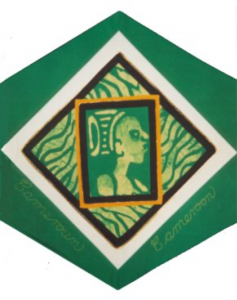Cameroon

The Block
The hand-dyed cotton of Madame Blandine Ghaho’s Cameroon block is a dramatic example of the fabric typically used by women for their daily dress and for their distinctive headdresses. It is produced using the ancient art of batik in which wax, vegetable paste or even mud is applied to cloth to resist dyeing. The brightly framed profile of a village woman stands out in sharp contrast to the gentle tones of green, the colour of hope and ecology, used throughout the design. Her neck is decorated with cowrie shells, which were used in the past as currency, due to their rarity. These shells can be seen on many Cameroonian artifacts, as well as artwork or clothing. Her headdress is typical of the way it is worn in Cameroon. A single line of rich gold thread stitched inside the frame and the double band bordering the entire square reflect the people of Cameroon’s belief that wearing gold surrounds an individual with protection, which will be followed by good fortune. Madame Blandine chose two colours of the national flag on her block: green for the tropical rainforests of the south and yellow for the sands of the northern desert.
Cultural Profile
Deriving its name from the Portuguese word for shrimp (cumarões), the Republic of Cameroon was named as a result of the large number of giant prawns the Portuguese found at the river’s mouth. Often referred to as ‘Africa in miniature’, it is one of the most diverse countries in Africa, made up of deserts, equatorial forests, wide rivers and white sandy beaches. The people are equally as varied with approximately 200 ethnic groups, speaking as many different languages, while harmoniously living together. French and English are the official languages of Cameroon, a legacy from years of colonization by several European countries. In urban areas of the country, some of the young people have taken to speak Camfranglais, a hybrid of English, French and Creole. Cameroon has one of the highest literacy rates in Africa.
Cameroonians are extremely hospitable and live by the golden rule of providing a pleasant welcome to all visitors. What often sets them apart from other Africans is “their zest for life and their open curiosity regarding people from other parts of the world.” Their cuisine is extremely varied, boasting a mix of European flavours with a wide variety of African specialties. The country’s chief exports are oil, timber, cocoa, aluminium, coffee and cotton. The fertile land allows for farming, while the lush forests provide wood products, and Cameroon also has vast mineral resources.
In this ‘’Africa in miniature’’, the arts and crafts are vibrant and varied. Each region and ethnic group has its own special craft. Basketry is made of dried palm leaves, bark wood or raffia. Wooden masks are carved and they represent a wide array of subjects such as animals, ancestors, spirits, kings and queens. Traditional clay passport masks are used as a form of identification when leaving and entering different territories. The style, design and colour indicate from which tribe or region the person carrying it originates.
Fibre art is rich in Cameroon. Tapestry crochet is done both by men and women. The technique of batik is used to produce clothing, accessories and art. Obom bark is beaten into a fabric and can be used to make clothing, or even shoes. Robes such as the toghu are embroidered with vivid colours on black fabric. Weaving, traditionally done by men on simple pedal looms, is used to produce textiles such as country cloth or Ndop, where raffia-stitching and resist-dyeing are used to produce an indigo and white heavy cotton fabric which was originally worn by royalty on very special occasions. The contemporary textile and fashion designers from Cameroon are internationally renowned for reinterpreting the country’s traditional techniques and styles to produce beautiful pieces that appeal to young generations.
The 10,000 Cameroonians living mainly in Quebec proudly share their culture within the African community and lovingly work to keep it alive through their cuisine, art and clothing.
Sponsor: Anonymous
